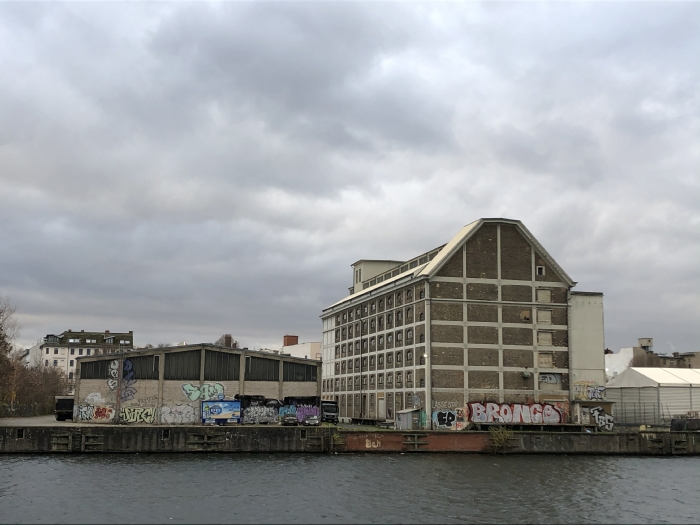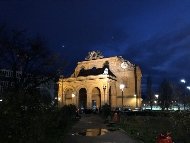


Berlin South

Speers Schwerbelastungskörper was ment to test if the Berlin grounds could carry the large buildings that were planned. (pictures: the Hitlerpages, 2017)

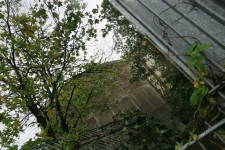
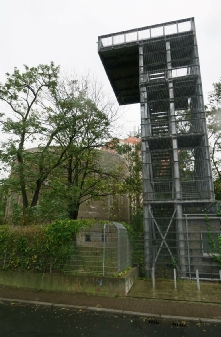

Germania, Triumphal Arch and South Station (22-
Location: Arch: Bridge between the Dudenstrasse and the Kolonnenstraße. Station: At the end of the road, somewhere in the area of the General-
Today: Never realised
Adolf Hitler and Albert Speer had great plans with Berlin. An impressive road with large buildings had to run from the Platz der Republik to the General-

A scale model of Germania. In front is the roof of the South Station. Behind it is the Arc de Triomph and in the back is the Great Hall.
(picture: Het Nazisme, 2007)
Practice Theo Morell 1935 -
Location: Kurfürstendamm 216 (corner Fasanenstraße)
Today: Still there.
Theo Morell replaced his old practice for a better one on the Kurfürstendamm in 1935, but Morell travelled a lot, because Hitler wanted him around when he was not in Berlin.
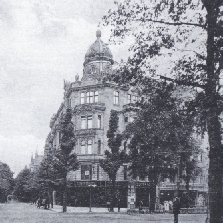
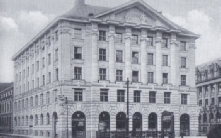
Morells practice was located at the first floor of this building on the Kurfürstendamm
(picture: Neumann and Eberle, 2009)
The Engel Apothek on the Mohrenstraße. This is the building where Morell got Hitler's medication.
(picture: Neumann and Eberle, 2009)
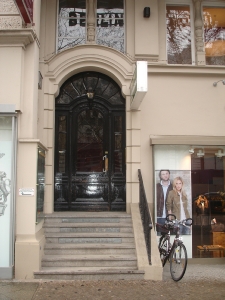
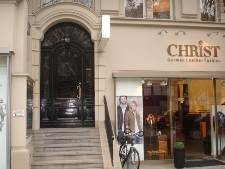
Kurfürstendamm 216 today
(pictures: the Hitlerpages, 2010)
House of Leni Riefenstahl (34)
Location: Heydenstrasse 30
Today: Still there
In June 1937, after Leni Riefenstahl bought a new house in Berlin, Hitler and Goebbels came to take a look at it.
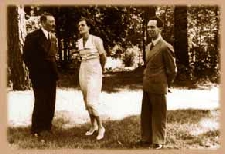
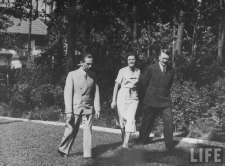
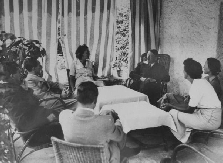
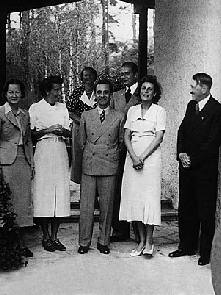
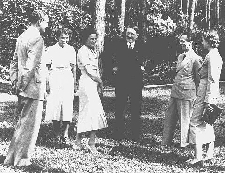
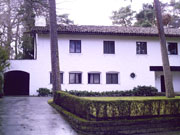
Hitler, Riefenstahl and Goebbels in the garden of Riefenstahl’s new house
A picture from LIFE Magazine of Goebbels, Riefenstahl and Hitler in the garden of the house
(picture: LIFE magazine)
The same group of people in the garden of the villa
Ilse Riefenstahl, Frau Dr. Ebersberg, Bertha Riefenstahl, Josef Goebbels, Heinz Riefenstahl, Leni Riefenstahl and Adolf Hitler at the house on the Heydenstrasse
The house that was once the property of Lenis Riefenstahl is still there.
Office Goebbels (35)
Location: Berliner Strasse
Today: Unknown
The first office of Josef Goebbels in Berlin was located somewhere in the Berliner Straße.
Goebbels in his office on the Berliner Straße (picture: Van Capelle and Van de Bovenkamp, 2007)
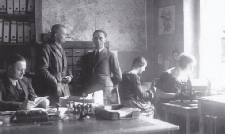
Villa Von Ribbentrop (36)
Location: Lentzeallee 7-
Today: New built houses
The villa that used to be here belonged to foreign minister Von Rippentrop. Hitler and Von Papen met here in Januari 1933 to negotiate about Hitler’s appointment as chancellor.
Adolf Hitler visits Von Ribbentrop on his 46th birthday on April 30 (!), 1939 at Von Ribbentrops villa in Berlin Dahlem. (picture: Van Capelle and Van de Bovenkamp, 2007)
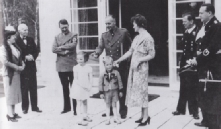
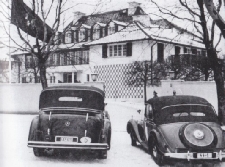
Von Ribbentrop’s villa with Himmlers car in front of it. (picture: Van Capelle and Van de Bovenkamp, 2007)
Practice Theo Morell 1919 -
Location: Bayreuther Strasse 7
Today: Post-
Theo Morell had his practice here until 1935.

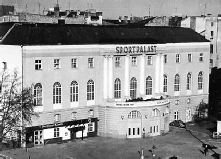


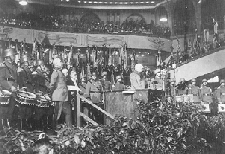


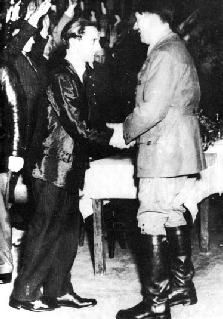
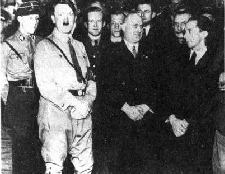
Left: Inside the Sportpalast in 1932 Right: Hitler and Goebbels shaking hands at the Sportpalast on January 20, 1933 (pictures: Hitler's Handlangers, 2004)

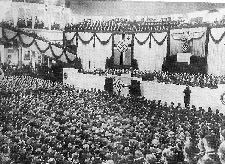
The Sportpalast after the war
(picture: copyright unknown)
The Sportpalast was in 1977 replaced by a pretty ugly building called the Sozialpalast. It is called the Pallasseum now.The flat is built over a Hochbunker. (pictures: the Hitlerpages, 2017)

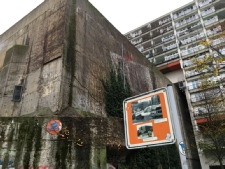
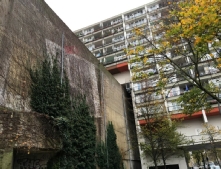
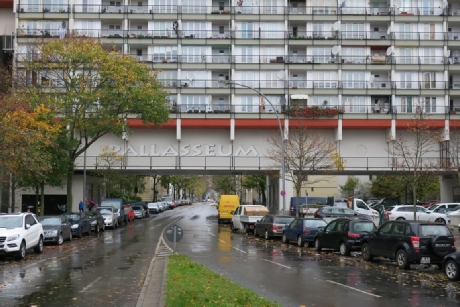
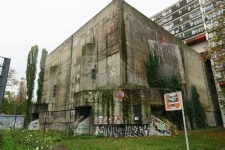
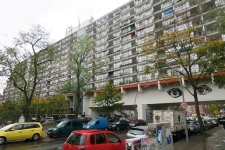

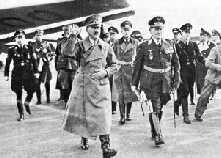

The Tempelhofer Feld on May 1, 1935
(picture: www.napolun.com)
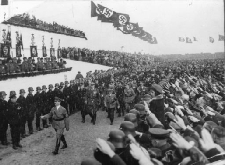
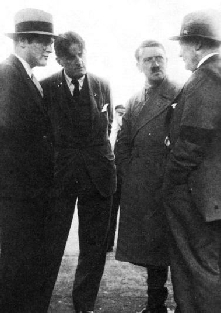
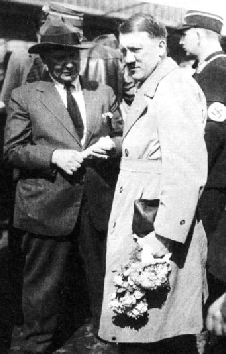
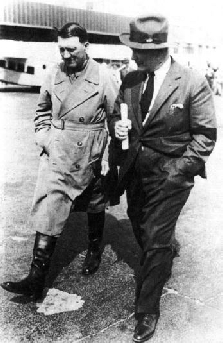
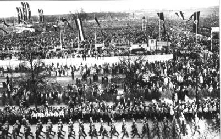
Hitler arrives at Tempelhof on the 30th of November 1932.
(pictures: Hitler's Handlangers, 2004)
Tempelhof on May 1, 1933
(picture: Reichshauptstadt Berlin, 2009)
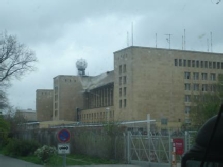
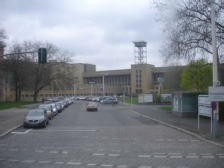
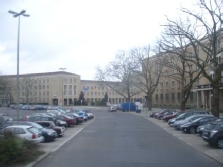
Airport Tempelhof is not longer in use as an airfield. (pictures: the Hitlerpages, 2011)
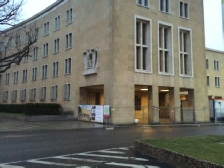
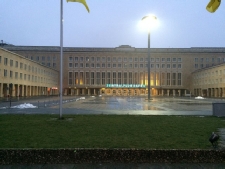
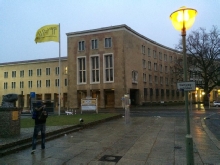
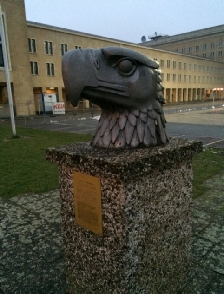
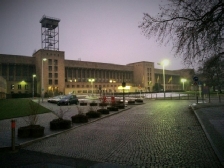
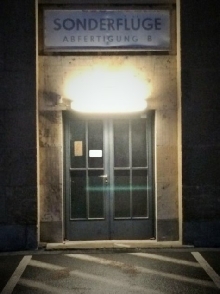
The head building of Tempelhof (pictures: the Hitlerpages, 2015)
Goebbels address in 1933 -
Location: Hedemannstraße 10
Today: Still there
In the Berliner Adressbücher of 1933 this was mentioned as the address of Josef Goebbels. It was the address where the NSDAP-
Hedemannstrasse 10 today
(picture: the Hitlerpages, 2014)
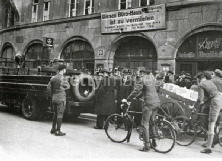
Police detachment in front of the headquarters of the NSDAP in Berlin, Hedemannstrasse. On the window on the right is the sign of Der Angriff. (picture: Getty Images, 14 April 1932)
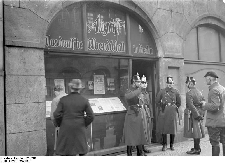
Goebbels headquarters in1932 (picture: wikipedia, Bundesarchiv 1932)
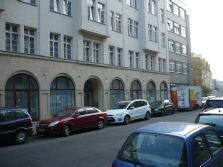
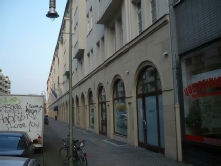
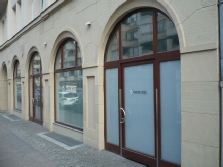
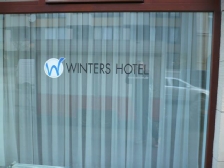
Hedemannstrasse 10 today
(pictures: the Hitlerpages, 2014)
Volksgerichtshof (people’s court) (44)
Location: Elsshozstrasse 30-
Today: There’s still a court at this location, the so called Kammergericht. The building has been reconstructed like the original building. A memorial stone is at the park entrance.
The political court of the nazi’s, the Volksgerichtshof, was at first seated at the Pruissian House of Representatives (later Görings Fliegerhaus at the Prinz-
The Volksgerichtshof at the House of Prussian Representatives on the Prinz-
(picture: Bundesarchiv, 1934)
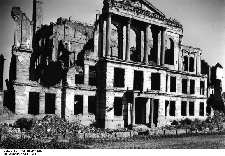

The ruined location of the Volksgerichtshof near the Potsdamer Platz
(picture: Bundesarchiv, 1951)
House of Hermann Epenstein
Location: Fregestrasse 19
Today: Still there.
In 1896, when he was still a young boy, Hermann Göring and his family moved in with Hermann Epenstein. Hermann Göring’s mother had a relationship with him. Her husband stayed somewhere else.
The Göring family in 1998 at the house of Hermann Epenstein
(picture: source unkown, 1898)
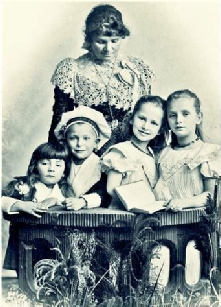
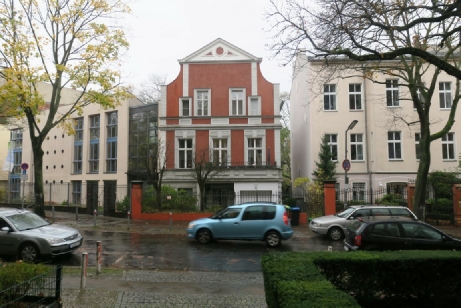
As a boy Hermann Göring lived at the red house for a few years.
(picture: the Hitlerpages, 2017)
Restaurant ‘Alois’ (12)
Location: Wittenbergplatz 3 (if the numbering hasn’t changed)
Today: There was an Italian restaurant on this address called Mola. The building was taken down in 2015. A new hotel is built there.
Adolf Hitler's half brother Alois had a restaurant here.
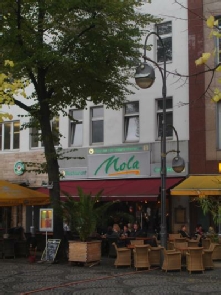
The former restaurant of Alois Hitler was called Mola.
(pictures: the Hitlerpages, 2009 & 2011)
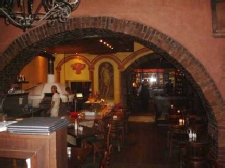

A postcard of the restaurant ‘Alois’
(scanned postcard (1940) received from a helpful source from Holland)
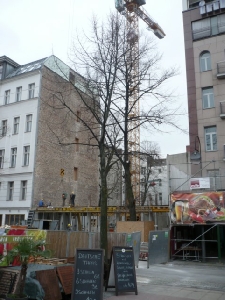
The location of the restaurant after it was taken down.
(picture: the Hitlerpages, 2015)


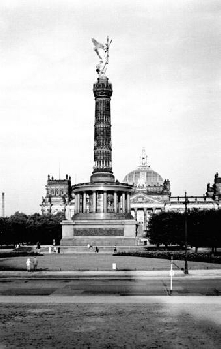
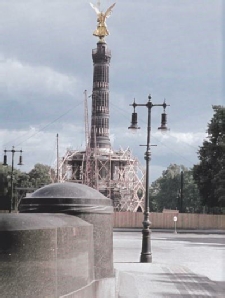
From left to right: The Siegessäule on the Königsplatz in 1930 (Berlin, Damals und Heute, 2009), the pillar under construction (picture: Reichshauptstadt Berlin, 2009) and the Siegessäule today. Albert Speer added an extra part to the pillar, as you can see on the picture on the right. (picture: the Hitlerpages, 2006)
Albert Speer’s Streetlights (14)
Location: Along the Strasse des 17 Juni
Today: A lot of the streetlights are still there.
Germania was never realised and the new Reichskanzlei was ruined after the war, but Albert Speer left Berlin the streetlights along the Strasse des 17. Juni.
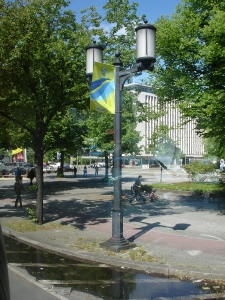
The streetlights designed by Albert Speer (picture: the Hitlerpages, 2004)
Bendlerblock/Reichswehrministerium (15)
Location: Stauffenbergstraße (originally named Bendlerstrasse), south of the Tiergarten
Today: Still there
The Bendlerblock was erected between 1911 and 1914 and used by the Reich Navy Office. During the Weimar Republic the building served as the seat of the Reichswehr Command. The building serves as secondary office of the German Federal Ministry of Defence. It also is a major memorial for the plot against Hitler's life on July 20, 1944. In the courtyard of the building the conspirators (including Graf von Stauffenberg) were executed. On March 13, 1937 Hitler held a speech for Generalfeldmaschall von Blomberg, who served the army 40 years.
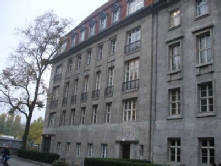
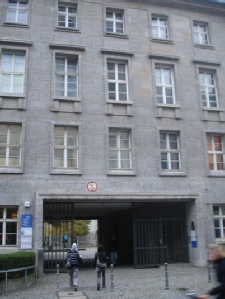
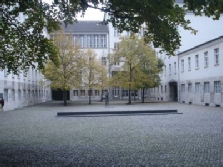
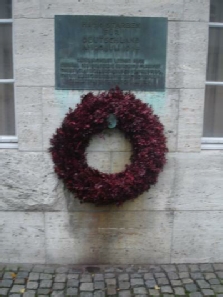
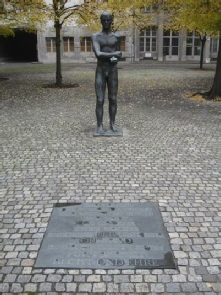
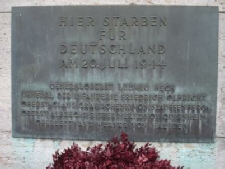
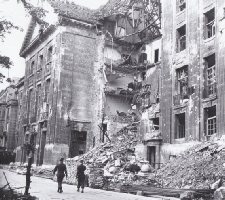
A bombed Bendlerblock at the end of the war (picture: Van Capelle and Van de Bovenkamp, 2007)
The Bendlerblock and its courtyard where Stauffenberg was executed (pictures: the Hitlerpages, 2009)
House of General Hammerstein-
Location: Ostflügel of the Bendlerblock, Stauffenbergstraße (originally named Bendlerstrasse), south of the Tiergarten
Today: The Bendlerblock is still there.
On February 3, 1933 Hitler spoke for the army leaders at the house of general Hammerstein-
Speech to Reichswehrgenerälen (15)
Location: Unknown
During a meeting of the army command and the leaders of the SA on February 28, 1934 Hitler made very clear that the Reichswehr would be the only army of Germany. The SA was going to be an institute for ideological education. Röhm, the leader of the SA was very angry and he expressed his criticism on Hitler. The SA secretly continued to arm itself.
Haus des Deutschen Fremdenverkehrs (Runde Platz, Germania) (16)
Location: Potsdammer Straße, right across the road from the Sigismundstraße. On the location of the Staatbibliotheek.
Today: Not longer there. The Staatsbibliotheek is there now. The building was ruined in the war. The ruïnes were taken away in the 50’s.
The house of German tourism was part of the plans for the new Germania Hitler was going to built. In fact it was one of the few parts of Germania that was almost finished.On June 14, 1938 Hitler layed the first stone of the German House of Tourisme on the Runde Platz. More information about Germania can be found here: kunst.gymszbad.de.
Hitler lays the first stone of the Haus des Deutschen Fremdenverkehrs.
(picture: Bundesarchiv, www.wikipedia.de)
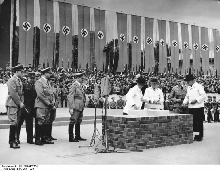
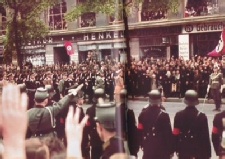

Hitler walking towards the Haus des Deutschen Fremdenverkehrs on the Potsdammerstraße for the opening ceremony in 1938.
(picture: Reichshauptstadt Berlin, 2009)

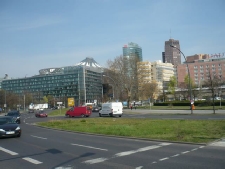
The Staatsbibliotheek was built on the location of the Haus des Fremdenverkehrs.
(pictures: the Hitlerpages, 2014))
Hotel Sanssouci (17)
Location: Linkstrasse 37, corner Reichpietschufer/Linkstrasse
Today: Modern buildings
On October 14, 1930 Hitler held a speech at the hotel Sanssouci. Earlier that year (on May 21-
Hitler must have stayed at this hotel on a few other occasions too. It is said that when William Patrick Hitler talked to the English press about Adolf Hitler and family-
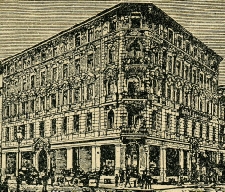
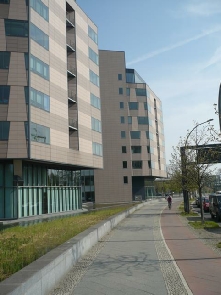
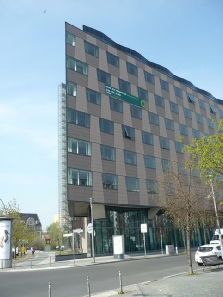
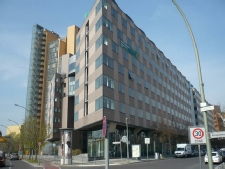
The corner of the Reichpietschufer and the Linkstrasse (pictures: the Hitlerpages, 2014)
A drawing of hotel Sanssouci
(source: www.hauptstadtberlin.org)
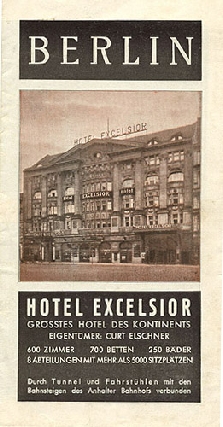
Hotel Excelsior (18)
Location: Askanischer Platz, across the street from the Anhalter Bahnhof
Today: Gone
The Hotel Excelsior was one of the biggest and most modern hotels in the world. Here the Nazi Party wanted to go on the eve of their assumption of power. The owner of the hotel must have turned down the honour. The hotel Kaiserhof was their second choice for that event.



The hotel Excelsior
The Excelsiorhaus
(picture: the Hitlerpages, 2014)
The area across the road from the ruïnes of the Anhalter Bahnhof
(picture: the Hitlerpages, 2014)

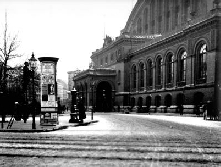
Anhalter Bahnhof in 1902
(picture: Berlin, Damals und Heute, 2009)
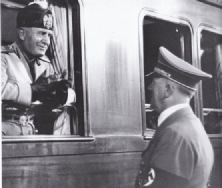
Hitler and Mussolini at the Anhalter Bahnhof (picture: Van Capelle and Van de Bovenkamp, 2007)


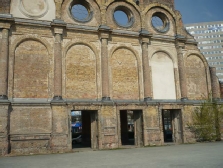
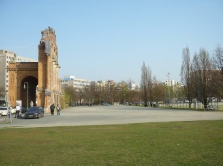
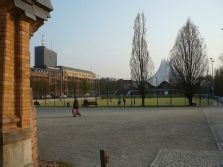
The remains of the Anhalter Bahnhof
(pictures: the Hitlerpages, 2014)
Behind the former entrance of the station is a sporting field that lies a little lower than the area around it: probably the location where the tracks ended. (pictures: the Hitlerpages, 2014)
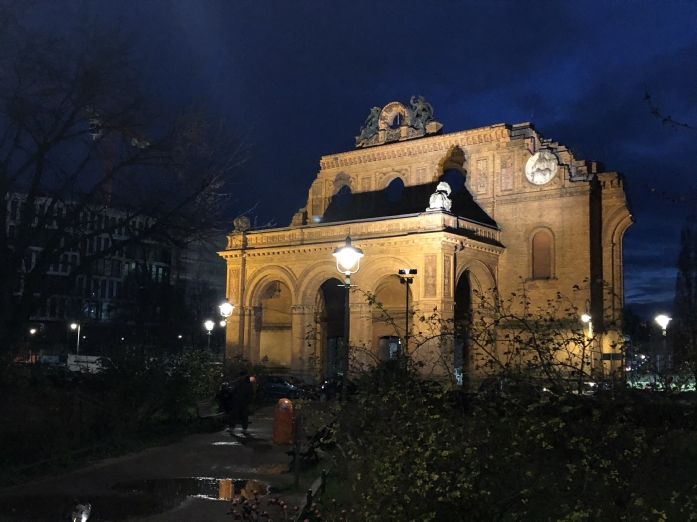
The ruins of Anhalter Bahnhof by night
(picture: the Hitlerpages, 2019)

A map with the location of Hotel Rheingold marked in black.
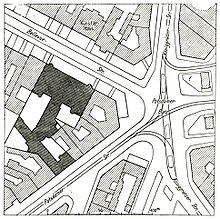
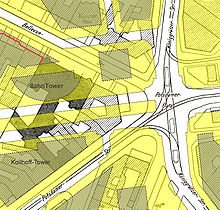

Another map of the area of Hotel Rheingold, with the plan of modern Berlin in yellow. Notice the tower of the Deutsche Bahn over the Bellevue side of the Rheingold building. The new Potsdamerstrasse runs right across the location where the backside of the building used to be. (map: wikipedia)
Hotel Rheingold on the Bellevue Strasse
The back of Hotel Rheingold on the (Alte) Potsdamerstrasse
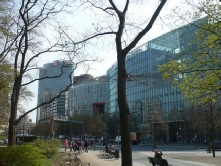
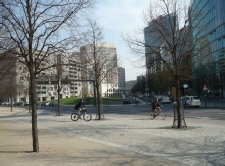

The Potsdamerstrasse today runs right through the location where the hotel buildings were. The high building in the centre of the picture (the Kollhoff-
The Bellevue Strasse today. The front of Hotel Rheingold was where the building of the Deutsche Bahn is now.


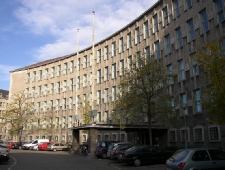
This building was originally used by the Nordstern-
Tennishallen (Wilmersdorfer Tennishallen) (3)
Location: Brandenburgische Strasse corner Konstanzer Strasse
Today: A depot of the Berliner Hafen-
The Tennishallen were built in 3 months in 1930. The hall served as a depot for ammunition in the war. On January 27, and February 10, 1932 Hitler spoke at the tennishall .

The Wilmersdorfer Tennishallen at the end of the war
Technische Hochschule, Wehrtechnische Fakultät (5-
Location: Straße des 17. Juni, remains of the planned Wehrtechnische Fakultät are behind the Telefunken-
Today: The Hochschule is called Technische Universität Berlin today. Parts of the old building are still visible. The Wehrtechnische Fakultät V was never finished.
On November 27, 1937 Hitler held a speech when the first stone was layed of the Wertechnischen Fakultät of the Technischen Hochschule.
The building of the Technische Hochschule in 1895
(picture: public domain, www.wikipedia.de)
The Technische Universität in 2006. On the right, one of the walls of the old building is still there.
(picture: www.wikipedia.de)

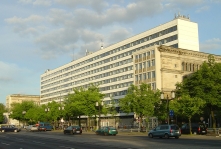
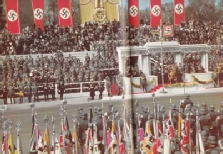

Geburtstagparade 1939. Hitler watches the parade pass the Technische Hochschule.
(picture: Reichshauptstadt Berlin, 2009)
Hitler watching the parade pass the Technische Hochschule
(picture: Hitler, de aanslagen, 2006)
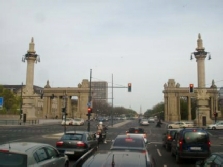
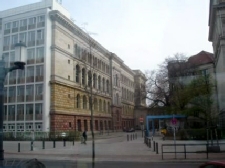
Only a wall remains of the old Technische Hochschule.
(picture: the Hitlerpages, 2011)
The parade Hitler watched, came past Charlottenburg gate.
(picture: the Hitlerpages, 2011)
Speech for students
Location: Unknown
On February 4, 1933 Hitler spoke to students in Berlin at an unknown location.
A meeting at the university in 1934. If Hitler was present or on what exact date this picture was taken, I don’t know.
(picture: Bundesarchiv, www.wikipedia.de)
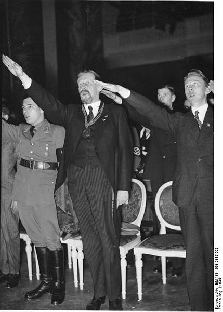
Opel Eduard Winter and other locations were William Patrick Hitler worked (8)
Location: Kurfürstendam 207
Today: Not sure
William Patrick Hitler worked in Berlin for a while, for the following companies:
1. Reichskrecht Gesellschaft
2. Opel, Rüsselheim
3. Opel Eduard Winter, Kurfürstendam 207
4. Schultheiss-
Kaiser-
Location: Breitscheidplatz
Today: War memorial.
The ruïns of this church are a reminder of WW II. There’s a modern tower/chappel right next to it. Adolf Hitler visited the church at least once.
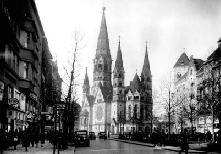
The Gedächniskirche in 1930
(picture: Berlin, Damals und Heute, 2009)
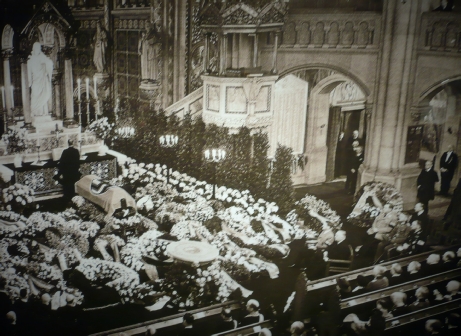
The Gedächniskirche on July 26, 1936. Funeral of Bernhard Wilhelm von Bülow. Hitler is present. (picture: Berlin, Damals und Heute, 2009)

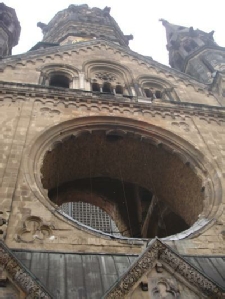
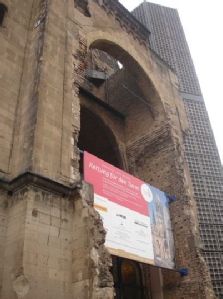
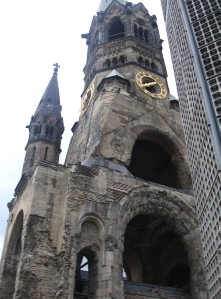
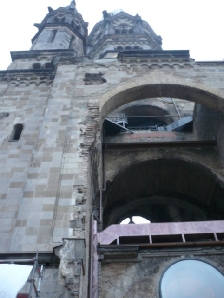
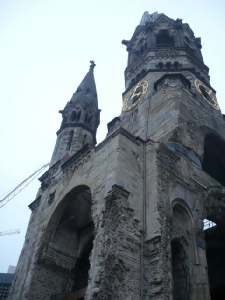
The Gedächniskirche is a reminder of the destructive power of war.
(pictures: the Hitlerpages, 2009-

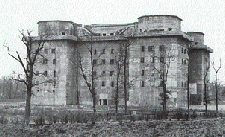

Berlin South
Berlin South here is the area south of the Bismarckstrasse, the Strasse des 17. Juni and south of it and south of the Karl-
1.Bar Alois Hitler 2. Hotel Rheingold 3. Wilmersdorfer Tennishallen 4. Fehrbelliner Platz 5. Wehrtechnische Fakultät 6. Ernst Reuter Platz 7. Technischen Hochschule
8. Opel dealer were William Patrick Hitler worked 9. Flakturm 10. Zoölogischer Garten 11. Kaiser-
21. Grossbelastungskörper 22. Arc de Triomphe 23. South Station 24. Tempelhof 42a. Neue Welt
25. Reichsbank 26. Görlitzer Bahnhof
27. Treptower Park 28. or 29. Kameradschaft der Deutschen Künstler (?) 30. Villa Ribbentrop 31. Leibstandarte Adolf Hitler 32. Practice Theo Morell 1919 -
34. House of Leni riefenstahl
35. Office Goebbels 36. Villa Von Ribbentrop
37. Address Goebbels and Angriff 38. Bahnhof Grunewald 39. Practice Dr. Dermietzel
40. Berliner Alte Philharmonie
41. Feurich-
Berlin South weergeven op een grotere kaart
Wineshop/bar of Alois Hitler (1)
Location: Leonhardstrasse 5, about 100 m. from station Charlottenburg
Today: Not sure.
Alois Hitler, the half brother of Adolf Hitler, had a wineshop/bar at the Leonhardstrasse.
House of Victoria von Dirksen
Location: Margarethenstraße 11. Bezirk W10.
Today: Scharounstrasse, Tiergarten. Near the Matthäikirche. The house is not there anymore. The area was severly damaged at the end of the war.
In this street Hitler sometimes met with his ‘mütterliche Freundin’ Victoria von Dirksen. She used to organise political gatherings. The NSDAP gathered at her house too.
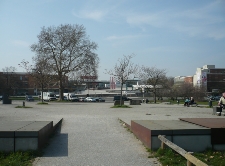
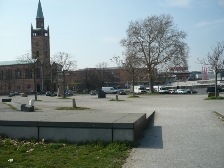

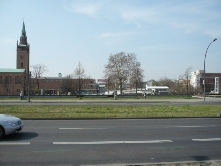


On this picture the Margarethenstrasse is in the background, left from the church. As seen from here, the street ran about a hundred meters behind the Matthäikirche. The picture was taken facing the area were the Sony Centre is today. (picture: copyrights unknown)
There was not much left of the buildings and houses in the area after the war. (picture: copyrights unknown)
The Matthäikirche was rebuilt after the war. (picture: the Hitlerpages, 2014)
The Matthäikirche and the square in front of it. The Scharounstrasse runs in front of the buildings on the right side of the picture on the right.
(picture: the Hitlerpages, 2014)
The square in front of the Matthäi-
Tailor Wilhelm Holters
Location: Tauentzienstrasse 16
Today: Shops (Douglas a.o.)
Wilhelm Holters made Hitler’s uniforms. His shop was located at the Tauentzienstrasse 16, in Berlin-
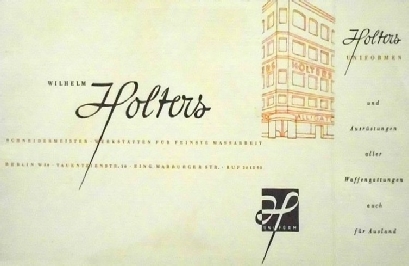
Two labels with the address Tauentzienstrasse 16 and a card with a drawing of Holters shop
(pictures: no copyrights)
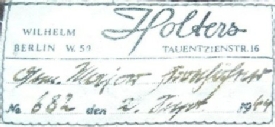
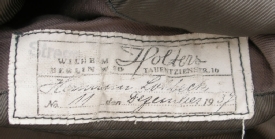


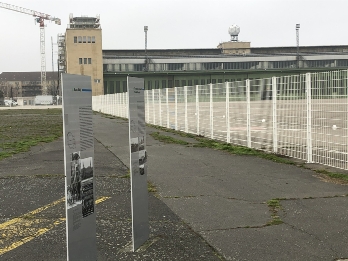
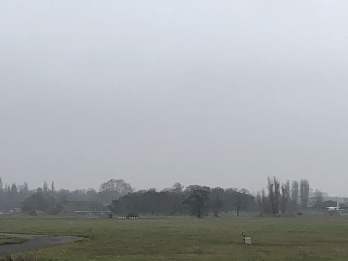
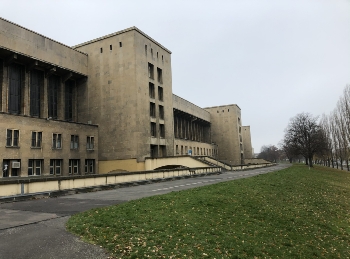
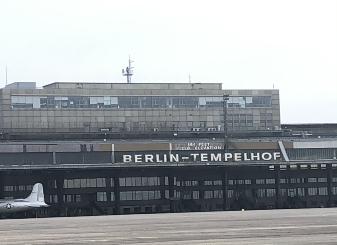
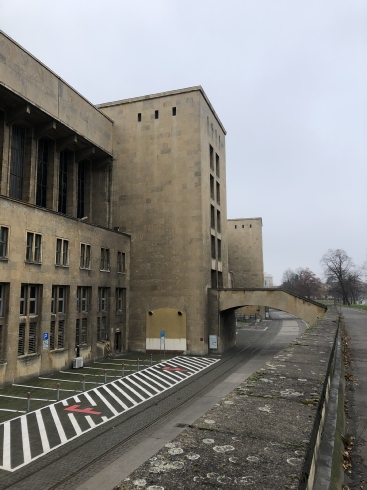
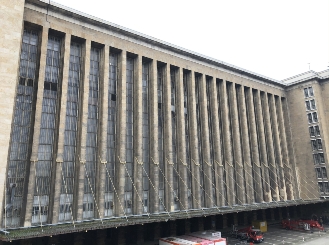


The entrance hall (left) and one of the wings of the airport. (pictures: the Hitlerpages, 2019)
An aerial view of the airport in 1930
(picture: Hauptstadt Berlin, 1990)
Kameradadschaft der Deutschen Künstler (28 or 29)
Location: Victoriastrasse 4
Today: Unknow
It is said that Hitler used to come here.

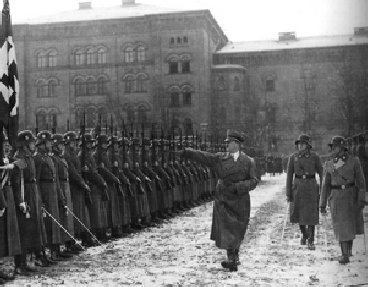
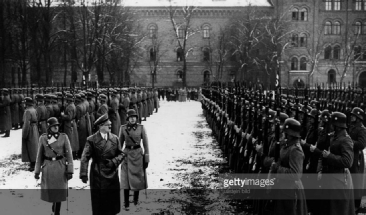

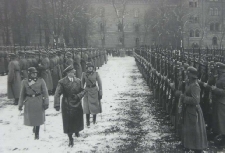
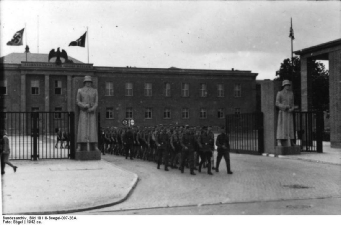



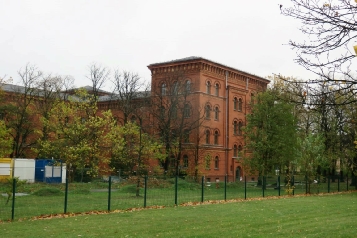

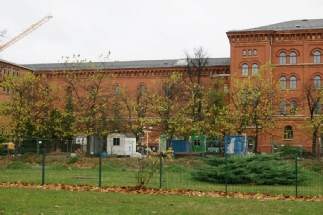




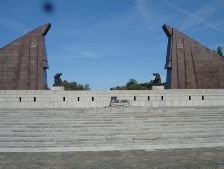
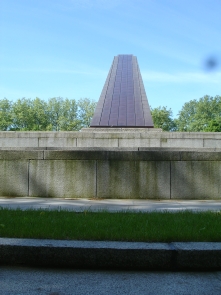

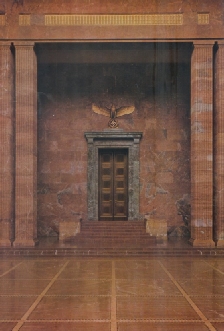

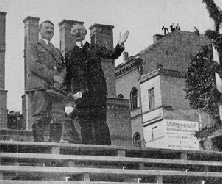

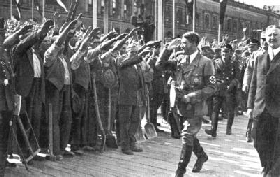
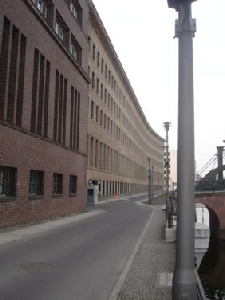
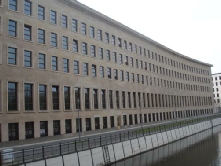


The Reichsbank has become the Foreign Ministry. (pictures: The Hitlerpages, 2010)
Görlitzer Bahnhof (26)
Location: Berlin south-
Today: Gone. There’s a park (the Görlizer Park) and a swimming pool now. The Spreewaldplatz used to be the Bahnhofsvorplatz. The U-
This station was the beginning of the track through Cottbus to Görlizt. Hitler used this Bahnhof for instance for his trip to Czechoslovakia. A picture below shows him returning from there.

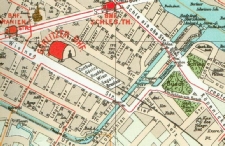
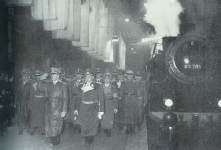
Görlitzer station in 1928
(picture: wikipedia, public domain)
Hitler arriving at the Görlitzer Bahnhof, after a trip to Czechoslovakia.
A map of the area of the station. There’s a park at this location today.
(map: wikipedia, public domain)

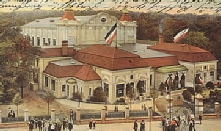
A postcard of Neue Welt of 1905
(source: unknown)
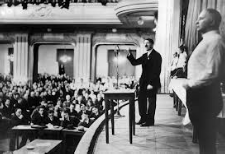
Hitler at the Neue Welt in 1930
(source: unknown)
A picture of the first mass meeting on the Tempelhofer Feld. Ther were about one million people present. It was one of the largest mass meetings during the Third Reich. In the back of the picture is the airport that was there before the then largest airport of the world was built. (picture: Bundesarchiv, 1933)
The tribune that’s on the picture of the mass meetig stood approximately on the location where the information stands are on the left picture. To see the location of the old airport you have to turn around. The location is where the trees are in the picture on the right. (pictures: the Hitlerpages, 2019)
Another impression of Tempelhof today (pictures: the Hitlerpages, 2019)
The tempelhofer Feld is now used for sports, flying a kite, hiking and for the activities of a youth circus. In the recent past refugees lived on the airport grounds. (pictures: the Hitlerpages, 2019)
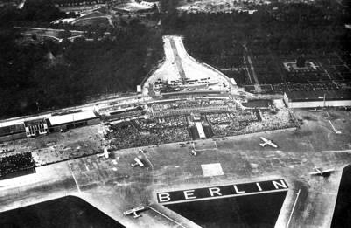
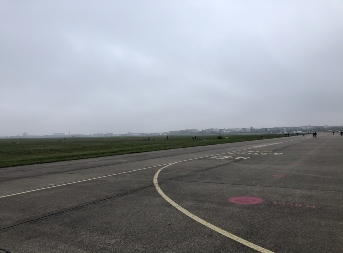
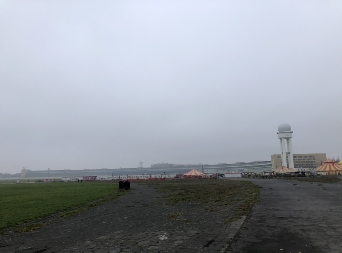
Bahnhof Grunewald (38)
Location: Am Bahnhof Grunewald
Today: Station with monument for the Jewish people who got transported to concentration camps from this station, called Gleis 17 (Track 17)
On December 6, 1944 Adolf Hitler took his train from this station to an unknown station in the Werra area, on his way to his Führerheadquarters Adlerhorst.
The head building of Bahnhof Grunewald is still there.
(picture: wikipedia)
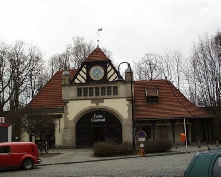
Practice Dr. Karl Friedrich Dermietzel (39)
Location: Berliner Straße 97
Today: Unknown
Hitler went to doctor Dermietzel at least once, most likely during the political campaign in 1932. There are documents that prove that Hitler saw him, but it is unclear if Hitler went to his practice or if the doctor came to see him. On April 4, 1932 Hitler was in Berlin for speeches. This could be the date he saw the dotor.
Berliner Alte Philharmonie (40)
Location: Bernburger Straße 22/Köthener Strasse
Today: The first Philharmonie in Berlin was located at the Bernburger Straße 22. In 1898 the Beethovensaal on the Köthener Straße was added to the Philharmonie. After the war the area was ruined. Today apartment buildings are on the grounds of the former Philharmonie. A new Philharmonie was built on the Kemperplatz between 1960 an 1963.
In November 1936 Adolf Hitler saw a concert here of the Londoner Philharmonic Orchestra, conducted by Thomas Beecham. On February 10, 1937 Hitler saw Wilhelm Furtwangler’s return to the concert platform here.
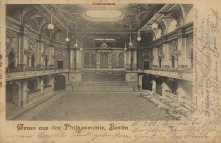
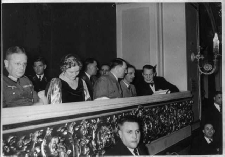
A postcard showing the inside of the Philharmonie in 1900
Emmy Göring, Adolf Hitler, Josef Goebbels and Hermann Göring at the Berliner Philharmonie on February 10, 1937.
Feurich Saal (part of the Schumann-
Location: Lützowstraße 75/76
Today: The J.S.Bach-
Adolf Hitler held a speech at the Feurich-
Victoria-
Location: Köpenicker Strasse 24a
Today: The warehouse was destroyed, a memorial plaque is placed at the entrance of the property.
The Victoria-

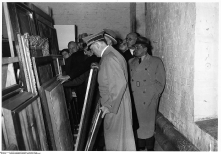
Adolf Hitler at the depot on the Köpenicker Strasse on January 13, 1938
(pictures: probably Heinrich Hoffmann, 1938)
The Victoria-
(picture: the Hitlerpages, 2019)
Heinrich Hoffmann’s Berlin photo agency and publishing house (43)
Location: Kochstrasse 10
Today: Kochstrasse 9 (near Checkpoint Charly). Hoffmann’s Berlin office was destroyed buy bombs at the end of the war. Today the plot that used to be no.10 is used by the Berlin Office For Education.
In 1934 Heinrich Hoffmann founded an office of his photo agency in Berlin. The area of the Kochstrasse was known as the newspaper district.
.
